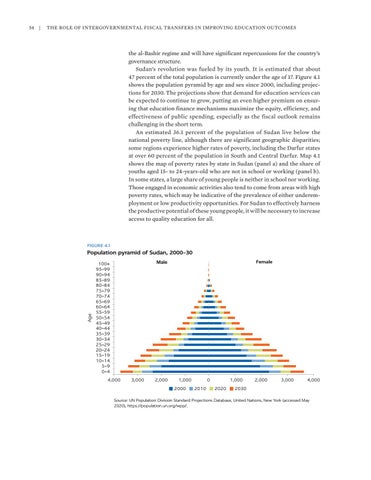54 | The Role of Intergovernmental Fiscal Transfers in Improving Education Outcomes
the al-Bashir regime and will have significant repercussions for the country’s governance structure. Sudan’s revolution was fueled by its youth. It is estimated that about 47 percent of the total population is currently under the age of 17. Figure 4.1 shows the population pyramid by age and sex since 2000, including projections for 2030. The projections show that demand for education services can be expected to continue to grow, putting an even higher premium on ensuring that education finance mechanisms maximize the equity, efficiency, and effectiveness of public spending, especially as the fiscal outlook remains challenging in the short term. An estimated 36.1 percent of the population of Sudan live below the national poverty line, although there are significant geographic disparities; some regions experience higher rates of poverty, including the Darfur states at over 60 percent of the population in South and Central Darfur. Map 4.1 shows the map of poverty rates by state in Sudan (panel a) and the share of youths aged 15- to 24-years-old who are not in school or working (panel b). In some states, a large share of young people is neither in school nor working. Those engaged in economic activities also tend to come from areas with high poverty rates, which may be indicative of the prevalence of either underemployment or low productivity opportunities. For Sudan to effectively harness the productive potential of these young people, it will be necessary to increase access to quality education for all.
FIGURE 4.1
Age
Population pyramid of Sudan, 2000–30 Female
Male
100+ 95–99 90–94 85–89 80–84 75–79 70–74 65–69 60–64 55–59 50–54 45–49 40–44 35–39 30–34 25–29 20–24 15–19 10–14 5–9 0–4 4,000
3,000
2,000
1,000 2000
0 2010
1,000 2020
2,000
3,000
4,000
2030
Source: UN Population Division Standard Projections Database, United Nations, New York (accessed May 2020), https://population.un.org/wpp/.






